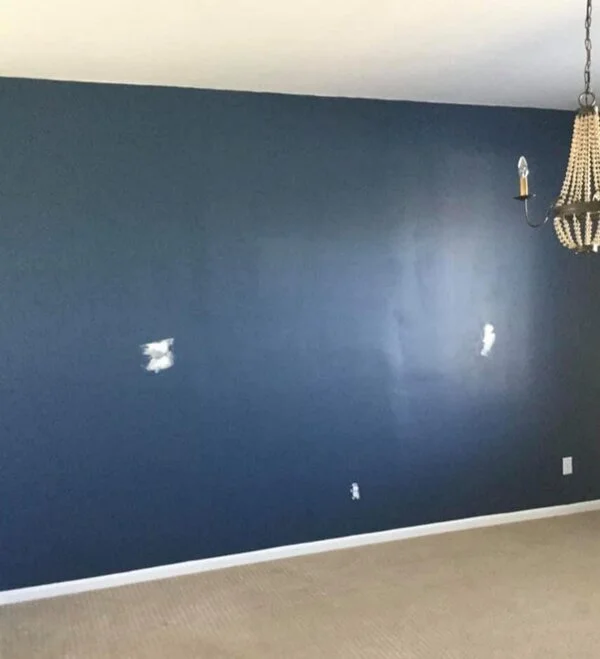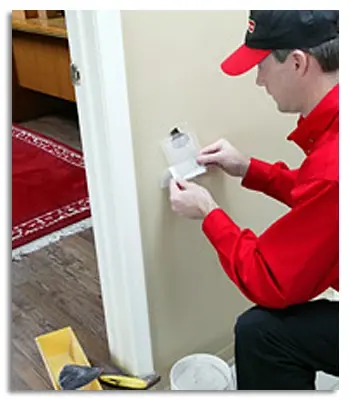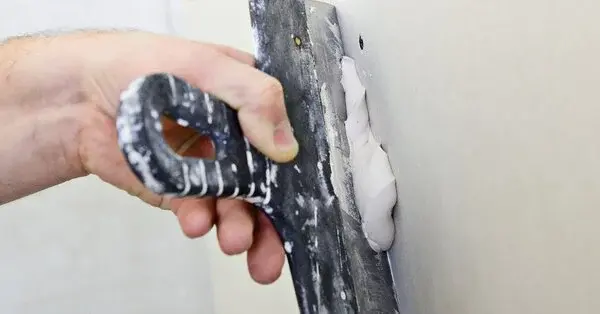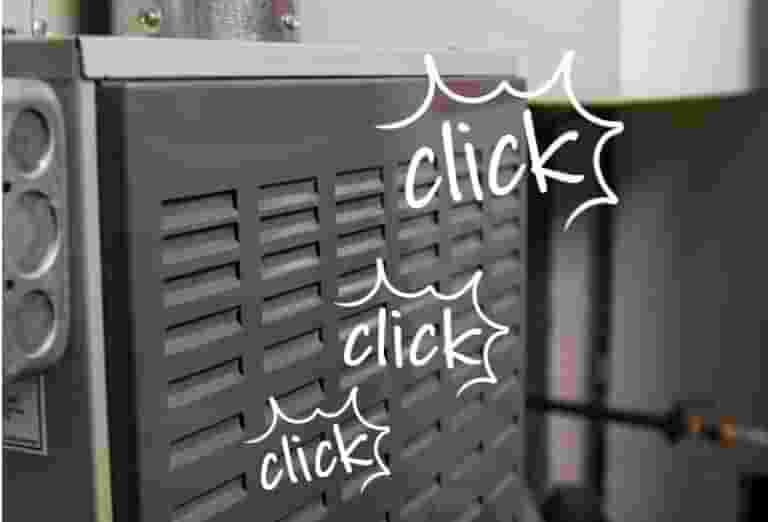
Drywall damage such as cracks, dents, chips, holes, stains, and other unsightly problems are just cosmetic issues that are hurting the appeal of your residential or commercial property. Those issues can also have serious effects that are totally unrelated to appearances, like a lack of sound separation, increased energy costs, pest infestations, and more. Homeowners and business owners can avoid all those issues by getting a drywall repair in Brighton, CO. Our local experts at Mr. Handyman of Brighton and Surrounding Area will take care of all those pesky nicks and holes.
Furthermore, knowing where each type of wall material is located will help you understand the drywall repair and ceiling repair procedures that our professional contractors will carry out.
What Types Of Drywall Repair in Brighton Do You Need?
There are various types of drywall damage that can occur. From cosmetic issues to emergency repairs, our Brighton handyman professionals can cover them all.
- Holes: These can be caused by accidental impacts, doorknobs, hitting the wall, or nails/screws being removed. They can range in size from small dents to larger openings.
- Cracks: Cracks can result from the settling of the building, temperature changes, or structural movement. They can appear as hairline cracks or wider fissures.
- Water Damage: Water leaks, flooding, or excessive moisture can cause the drywall to become soft, water stains to appear, discoloration, or develop mold growth. Water damage can weaken the structural integrity as well.
- Peeling Tape: Drywall tape is used to cover the joints between each of the sheets. Over time, the tape may loosen, bubble, or peel away from the wall, resulting in visible gaps or seams.
- Nail Pops: This happens when the drywall screws or nails push through the surface, creating a raised bump or visible indentation. This can be caused by the settling of the building or improper installation.
- Texture Damage: If the texture finishes on your drywall or ceiling get damaged, it can appear uneven, chipped, or scraped. Common causes include accidental impacts, moisture, or improper repair attempts.
- Corner Bead Damage: Corner beads are metal or plastic strips used to protect and reinforce the corners of your walls. Damage can occur to a piece of corner bead from impacts, movement, or improper installation.
- Settling Cracks: Over time, buildings may settle, causing stress on the wall and resulting in visible cracks. These cracks are typically found near windows, doors, or ceiling/wall junctions.
- Impact Damage: Accidental impacts such as furniture bumps, door handle strikes, or rough handling during renovations can cause dents, holes, or cracks in the drywall.
- Nail or Screw Holes: When nails or screws are driven too deeply into the drywall during installation, they can break through the paper surface, leaving visible puncture marks.
These are some of the common types of damage, and each requires specific repair techniques to restore the integrity and appearance of the wall. It's advisable to consult with one of our professional experts to assess the damage and determine the appropriate Brighton drywall repair that is needed.
Our Brighton Drywall Repair Methods
There is no such thing as a one-size-fits-all approach for drywall repair in Brighton, CO. Our handyman professionals have seen and fixed a wide range of wall and ceiling damage issues, and the methods of repair are naturally going to vary based on the size of the damaged area. Small instances of surface damage require a much lighter touch to repair, for example, in comparison to severe issues like outright holes or patches that have been softened by excessive moisture. We'll start by evaluating the problem and explaining our recommendations for the best resolution.
Our Brighton drywall repair services include the following:
- Minor Damage: Filling spots of surface damage such as cracks, chips, hairline cracks, or nail holes in drywall with lightweight Spackle, then sanding the dried Spackle to a smooth finish and concealing it with a fresh coat of paint.
- Small Drywall Holes: Patch small holes that are less than four inches across with an adhesive mesh drywall patch, then cover the patch with a coat of compound and feather the edges in a crisscross pattern. Then, once it's dry, paint over the repaired area.
- Larger Hole Damage: Patching large holes or other types of damage by cutting out the damaged portion of a panel to the wall stud on either side, then installing a support piece and fastening a new piece of drywall to it. Then, apply joint tape around the edges of the patch and cover it with drywall mud. Once dry, we might need to apply another layer of joint compound. We’ll allow it dry again before applying texture spray and painting the whole wall.
Choose Mr. Handyman of Brighton and Surrounding Area for Drywall Repair

When you need a reliable, experienced Brighton drywall repair professional, simply call the team of skilled technicians at Mr. Handyman of Brighton and Surrounding Area. We'll get there on time for your appointment with all the tools and materials we need to get the job done to the highest standards of quality. Customer satisfaction is important to us, and we make sure you're pleased with the results of our work by always communicating clearly and never cutting corners. Furthermore, all our work is insured and covered by our warranty services. We offer a one-year warranty on all our parts and labor, so you know we will return and make it right. Customer satisfaction is our top priority.
Mr. Handyman of Brighton and Surrounding Area provides a wide variety of handyman services—from flooring repair to bathroom remodeling. We are your local experts, ready to handle all your repair, renovation, or maintenance projects. Reach out today to learn more or to book your service call with one of our expert craftsmen.
Brighton: Drywall Repair FAQs
What Are the Main Causes of Drywall Damage?
There are a lot of potential causes for damaged walls and ceilings. If it was a sudden impact, you probably know exactly how it happened, but sometimes the origin of the problem is less obvious. Some common causes are:
- Nail, drywall screw & thumbtack holes
- Drywall anchor holes
- Loose joint tape, popping nails & other symptoms of a building settling over time
- Scratches & chew marks from pets
- Water damage from plumbing problems, a leaky roof, or a poorly ventilated bathroom
- Popcorn ceiling removal was done too aggressively, damaging the surface underneath
- Cracks & deep holes caused by insect or rodent infestations
Are Drywall and Plaster the Same Thing?
They are often confused with each other, but they're actually quite different. Plaster is essentially the predecessor of drywall. Before drywall was invented, construction professionals would build walls and ceilings out of narrow strips of wood called laths, then cover the laths with layers of plaster. If they were good at what they were doing, the finished project would look very much like a smooth, even drywall surface. But drywall or Sheetrock panels were a very popular invention among building constructors because they are so much easier and faster to work with. That's a big reason why plaster and laths are rarely used these days, but drywall also provides some additional benefits that plaster can't match. Drywall leaves room for insulation, which means it's a more energy-efficient option and can save homeowners money on their utility bills over time.
What Are The Different Kinds Of Drywall?
There are several different types, also known as gypsum boards or plasterboards, each designed for specific applications based on their composition and characteristics. Some of the common types:
- Regular: Also known as whiteboard, it is the most common type and is used in all residential and commercial construction. Typically used for interior walls and ceilings in dry areas.
- Moisture-Resistant: A choice between green board or purple drywall, they have a water-resistant core and are commonly used in areas with high humidity to provide some protection against moisture but not direct water exposure. Green board is for moisture resistance, whereas purple is used as an enhanced resistance to prevent the growth of mold and mildew. Bathrooms, kitchens, and laundry rooms are the prime spots to use them.
- Cement Board: CBU (cement board underlayment) is a heavy-duty wall material alternative made of cement and reinforced with fiberglass. It is highly durable and commonly used as tile backing material in wet areas like bathrooms, showers, and kitchens.
- Blue Board: A type of wall material that is designed specifically for plastering as it provides improved adhesion for the plaster coatings.
Some other types that are more specialized for specific purposes are:
- Fire-resistant: designed for enhanced fire protection. Typically used in garages, utility rooms, and shared walls in living spaces.
- Sound-proofing: Another name is quiet rock, which has specialized materials that absorb or dampen sound vibrations. Commonly used in home theaters, music studios, and rooms where noise control is important.
- Impact-resistant: This has a double face and core that can withstand high levels of impact compared to regular sheets. Often used in high-traffic areas such as hallways, schools, or commercial buildings where the walls are prone to damage.
- Flexible: Has a thinner flexible core allowing it to be bent or curved to create a smooth arch or rounded surface. Customers choose this type to construct unique shapes for their walls, such as in architectural designs and custom installations.
How Can I Avoid Needing Drywall Repair Services in the Future?
Most drywall damage happens accidentally, so the occasional scuff or dent is to be expected, especially in a busy household. But there are some ways you can help protect it. Making sure you have baseboards installed, along with additional trim in some areas like chair rails to stop chairs from banging into the wall, can make a difference in the longevity of your walls and ceilings. It's also important to avoid water-related damage by keeping your roof and plumbing system in good condition and making sure rooms with high humidity are properly ventilated.
Call Your Local, Qualified Handyman for a Brighton Drywall Repair Service
Colorado property owners who live in Brighton or nearby areas of Thornton or Central Park can rely on the team of professionals at Mr. Handyman of Brighton and Surrounding Area for expert quality service and customer care that goes above and beyond.
When you need a Brighton drywall repair, pressure washing, gutter repairs, or any other handyman service, reach out and schedule a service call with one of our knowledgeable customer service representatives. Let Mr. Handyman of Brighton and Surrounding Area transform your living space back to the pristine condition it should be.
 Click to call
Click to call



 Click to call
Click to call
